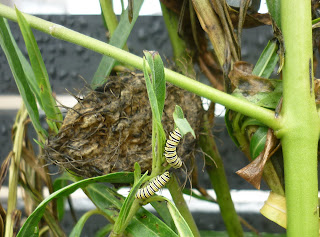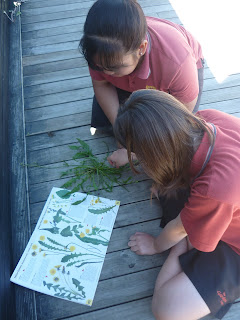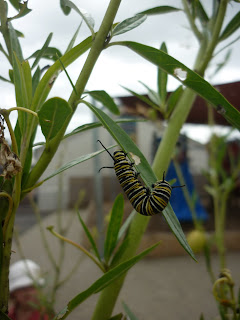A great loss occurred in our class's garden during the late hours of this morning. Part of our swan plant, home to our much-loved caterpillars, chrysalids and ladybirds (but not aphids) had split and torn away but the plant was still alive and growing. We had been following the progress of several caterpillars who had recently turned into chrysalids. (See previous blogs)
Huia 1 had just settled down to our
100 Need to Know Spelling Words end-of-term test when we noticed our caretaker cutting down our swan plant. Mrs Vincent was the first one to be shocked and she shrieked, "Aaaaaaaaaaaah...... the caterpillars!"
She dashed out of the room but it was too late. The caretaker had already cut the plant down and was piling up the branches on the court beside the garden. Mrs Vincent explained that our class was studying the life cycles of monarch butterflies and swan plants.
At that point, Mrs Vincent decided to postpone the spelling test and we launched a search and rescue operation instead. We brought all the branches inside and looked for survivors.

We found two baby caterpillars, many large caterpillars, a couple of chrysalids and many lady birds which we relocated on a swan plant near the junior classes.





We noticed that the tips of the branches on this swan plant were covered in aphids so we knew that they could affect the health of the new host swan plant. Because we knew that ladybirds eat aphids, we relocated as many ladybirds as we could find.


With the chrysalids, we cut the branches on which they were hanging and pegged them to a washing line in our class. We are going to keep them safe until they hatch into monarch butterflies. Some people will take them home to care for them over the weekend.


Terence and Nikhil found a caterpillar which was not a monarch butterfly caterpillar and went to the library to identify it. It looked like it was a cabbage butterfly caterpillar which meant we should have killed it, but it looked as if it was dying by itself.

Hoani found a praying mantis and Danny found a shiny blue lady bird. Tegan found a whitish lady bird with black spots where its eyes could have been but she doesn't think they were eyes. We also found a few small black and yellow/orange insects which we have yet to identify. In the classroom we have some eggs and a baby caterpillar on a swan plant branch in a glass of water and outside, we have bigger swan plant branches sitting in buckets of water.




Some caterpillars had been crushed underfoot as they fell off the plants and Callum saw another dead one being eaten by ants, so he buried them and put flowers on their grave and made a tombstone out of one of the succulent plant leaves. "That's respect," said Nikhil.



By lunchtime, we had just about finished the rescue. Meanwhile, in the classroom, some people were reading, catching up work in their Anthology books, and Michael, Tegan, Hunter, Fili, Shayla and Danny were picking up hundreds of tiny swan plant seeds which had dropped on our floor.
After all that, the spelling test was abandoned for the day and we wrote this recount about the events of the day instead. This had turned into an excellent learning experience because it showed how much knowledge we had learned since we discovered the first caterpillar on our swan plant a few weeks ago. We were proud of what we had done in such an unexpected event.
Mrs Vincent said, "Spelling test tomorrow..."
 Meantime, other eggs hatched on some of the rescued plants and branches which we are keeping alive in a bucket of water in the garden. There are at least five new caterpillars living on these branches.
Meantime, other eggs hatched on some of the rescued plants and branches which we are keeping alive in a bucket of water in the garden. There are at least five new caterpillars living on these branches.


 Can you find the tiny water droplet in this photo?
Can you find the tiny water droplet in this photo?

 If you look very closely, you might see and ant on one of the leaves, heading towards the aphids to collect their 'honey dew'.
If you look very closely, you might see and ant on one of the leaves, heading towards the aphids to collect their 'honey dew'.


















































